Nets for Polyhedra
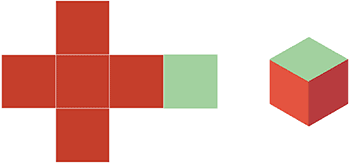 In this challenge, we ask you to find nets for shapes other than a cube.
In this challenge, we ask you to find nets for shapes other than a cube.
The Boxes, Cubes, and Nets [1] puzzle featured finding nets for cubes. A net is a two-dimensional shape that can be folded up to form a three-dimensional shape. For example, the hexomino (shape made from six squares) shown in the figure can fold up nicely to form a cube. The red squares fold up to form the base and sides of the cube; the green square folds over to form the top of the cube.
A cube is a special kind of three-dimensional figure called a regular polyhedron. A cube is a regular polyhedron because all of its faces are congruent regular polygons.
In this puzzle we will try to find nets for three related polyhedra: a regular tetrahedron (four equilateral triangular faces), a regular octahedron (eight equilateral triangular faces), and another common polyhedron, the square pyramid (four equilateral triangles and a square).
Challenge 1How many nets can you find for a tetrahedron? A tetrahedron has four faces, so each net consists of four equilateral triangles attached along their edges. |
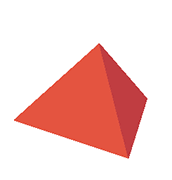 |
|
Challenge 2How many nets can you find for a square pyramid? A square pyramid has one square face and four triangular faces, so each net consists of one square and four equilateral triangles, attached along their edges. Try to find all the possible nets. |
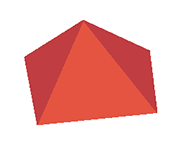 |
|
Challenge 3Find at least one net for a regular octahedron. See if you can find more than one. Each net will consist of eight equilateral triangles attached along their edges. |
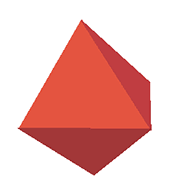 |
Background
First, a couple of definitions. A polygon is a closed two-dimensional shape whose edges are straight lines that do not cross each other. A polyhedron (plural: polyhedra) is a three-dimensional figure, solid or hollow, all of whose sides are polygons The word comes from the Greek, poly, "many," + hedron, "side" or "base." A regular polyhedron is one whose faces are all congruent regular polygons. Actually there are only five regular polyhedra, sometimes called "Pythagorean solids," the cube and four others: a tetrahedron (4 faces), octahedron (8 faces), dodecahedron (12 faces) and icosahedron (20 faces).

|
There are many, many Web sites that deal with the mathematics of polyhedra. Here are just a few: |
Two-dimensional and three-dimensional geometry are often studied as if they were different subjects. In this puzzle and "Boxes, Cubes, and Nets," we study one way they are related—through the construction of nets, two-dimensional shapes made of polygons that fold up into polyhedrons.
This puzzle makes use of three other important mathematical ideas.
The first of these is the concept of congruence, which is needed when we try to decide whether two shapes that look different are actually identical. Mathematically, two shapes are congruent if they have the same size and shape, regardless of their orientation. If you can pick up one of the shapes and rotate it, flip it over, and/or slide it so that it fits exactly on top of the other shapes, then the two shapes are congruent. This is one simple test for congruence. There are many others. As an example, consider these three shapes, each made up of four equilateral triangles and one square. Two of them are congruent? Can you tell which ones?
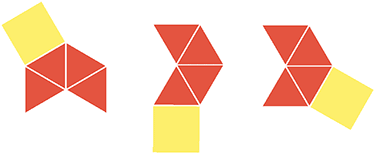 |
||
| 1 | 2 | 3 |
The second is the idea that you sometimes have to test to be sure whether two mathematical objects are the same or different. Just because two shapes look different, you can’t be certain they are different until you’ve picked one up and made sure it’s not congruent to the other. For nets, congruence is the test—but mathematicians have many other tests they can use for different types of problems.
The third is the idea of finding all possible ways to solve a particular problem. This is a common type of problem in combinatorics. For example, find all the possible ways to arrange the numbers from 1 to N. Or for a more everyday example, a restaurant serves pizza with four different toppings: onions, mushrooms, sausages, and extra cheese. How many different types of pizzas can they make using 1, 2, 3, or 4 of the toppings? (Of course, a real restaurant would probably provide many more than four toppings.)
Combinatorics problems involving geometry can be much more complex. For example, if N is the number of faces in a polyhedron, there is no known rule or formula that can tell you how many different nets can be constructed for a polyhedron with N faces. (Mathematicians have worked out the exact number of nets for many different polyhedrons, but no general rule has ever been found.)
There is an important problem solving strategy that can be used in this puzzle. Once you’ve solved one problem, you may be able to use the solution to the first problem to solve a harder one.
This content has been re-published with permission from SEED. Copyright © 2025 Schlumberger Excellence in Education Development (SEED), Inc.
Course:
- Math [3]
